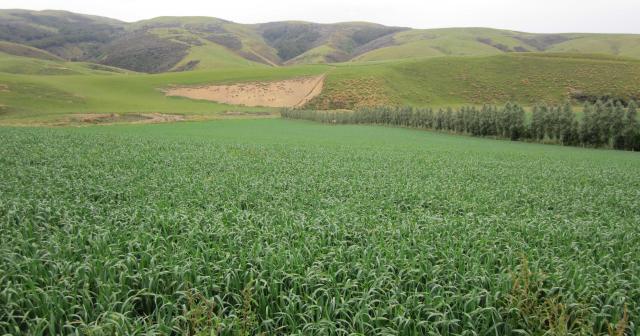Farmers looking to replenish depleted supplementary feed supplies this spring could consider planting a catch crop as soon as possible after their winter forage crops have been grazed.

Takeaways
- Planting catch crops as early as possible increases their effectiveness in reducing nitrate leaching and sediment loss and can boost the annual yield of a paddock.
- Other recommendations to reduce sediment and nutrient loss risk include maintaining grass buffers, resowing new pasture as soon as practical, and reducing the risk of soil damage caused by pugging.
- Cereals (e.g. oats, ryecorn, triticale, wheat or barley) are more effective than grass species (e.g. Italian ryegrass) as catch crops following a winter crop grazing.
Catch crops give farmers the ability to turn residual soil nitrogen (N) into high quality dry matter while reducing the risk of nitrate leaching.
Plant & Food Senior soil scientist Dr Brendon Malcolm led the Beef + Lamb New Zealand supported Catch Crops for Cleaner Freshwater project which trialled catch crops at both plot and farm scale.
This project highlighted the ability of these crops to capture large amounts of N that might otherwise have been lost to the environment and turn it into high quality drymatter. These crops can also help maximise the quantity of dry matter grown in a paddock over a 12-month period.
Dr Malcolm says that given that catch crops in these systems are typically sown at the coldest time of the year, the best sowing options are winter active crops such as oats, ryecorn, triticale and Italian ryegrasses which can be sown with a cereal such as oats.
He says it is important to get catch crops into the ground as soon as practicable after the paddock has been grazed, when soil temperatures are four degrees and above.
Timing is critical with catch crops and research has shown that sowing oats immediately after grazing has the greatest impact on reducing N losses. With every month that sowing is delayed, there is a notable reduction in effectiveness.
Dr Malcolm says while July-sown oats can be very slow to come away, they are still capturing a significant amount of N through their root system during the high-risk period, despite the small amount of above ground foliage.
Ideally the paddock should only be minimally cultivated, just enough to ensure good soil to seed contact, but pugged soils may require more cultivation.
Dr Malcolm says a high plant population is best to capture the N and maximise dry matter production and he recommends a sowing rate of 110-120 kg seeds/ha for oats to target an optimal plant population of 300 plants per square metre.
Weed control is also important.
While catch crops don’t initially require N, as they capture the residual N in the soil, when they start to come away more rapidly in late October and November, typically when leaching has ceased, Dr Malcolm says they may require a dressing of 40-50 kg N/ha to help maximise yield and quality.
For catch crops grown for green-chop silage, the timing of harvest is important. Ideally, the crop should be harvested when the oats just start to go reproductive. Quality can quickly decline after this stage.
A typical yield of a green chop silage crop sown after winter grazing is 6-10 t DM/ha with a feed value of around 11 MJME/kg DM.
While catch crops offer significant benefits, they are not suitable for every farm system. Taking an oat catch crop through to green-chop silage can delay the sowing of subsequent winter forage crops.
This is particularly the case with two-year fodder beet rotations as the optimum harvest time of the catch crop is past the essential sowing window for fodder beet.
However, research how shown that when balanced out over a 12-month period, a paddock will grow more feed in total when a catch crop grown for green chop silage follows a winter forage crop such as kale.
A particularly wet spring may also make it difficult to establish catch crops in time to fully capture their benefits.
The Catch Crops for Cleaner Freshwater project was funded through MPI’s Sustainable Land Management and Climate Change – Freshwater Mitigation programme in partnership with Beef + lamb New Zealand, Plant & Food Research, AgResearch, DairyNZ, Foundation for Arable Research, Southern Dairy Hub, Environment Canterbury and Environment Southland.
Find out more
- To hear more, listen to Catch crops: a way to reduce N leaching after winter crops podcast, with Dr Brendon Malcolm, Plant & Food Research.
- Read more about catch crops: Catch crop guidelines for reduced nitrate leaching (PDF, 2.8MB)